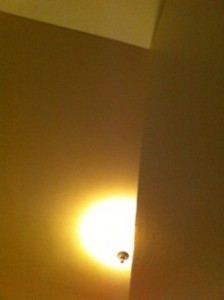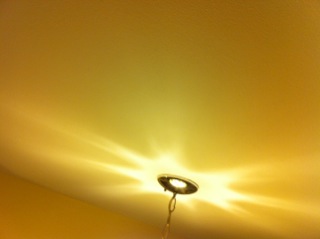Inspiring Interior Design (Part 11)
By Asher Crispe: August 20, 2012: Category Inspirations, Quilt of Translations
Lighting Your Interior
Once again–casting my house as the world and the world as my house–our study returns to the opening of the Genesis narrative. In the beginning of the word ‘in the beginning,’ in the first Hebrew letter of this word (as we mentioned previously regarding the large beit of bereshit), Creation acts the part of a macrocosmic home. Setting up this home, the Creator at first only communicates the vaguest of generalizations. ‘Heavens’ and ‘earth’ leave a lot to the imagination. What follows however, in the subsequent unpacking of the details that fill in the particular features of Creation during the rest of the ‘week of installation,’ counts as the greatest proof for the prioritization of lighting over all of the other interior design aspects. From day one, we need to follow this example of Divine creativity, and set up the lights.
Light changes everything. We cannot even appreciate the beauty of our home’s interior without it. Having the right light can make or break the ambiance of a room. This in turn necessitates differentiating between types of light, vetting their suitability for deployment and understanding their optimal configuration. Use of inadequate lighting, the wrong quality of light, or poor distribution of light sources will destroy the decor of the house. This cannot be remedied by other means; only changes in the lighting plan will do the trick.
So with everything else being prepared with the light in mind, God’s first pronouncement on the first day of Creation went as follows (Genesis 1:3-5):
“And God said: ‘Let there be light.’ And there was light. And God saw the light, that it was good; and God divided the light from the darkness. And God called the light Day, and the darkness He called Night. And there was evening and there was morning , one day.”
Thus, before we have the waters, firmament, plants, natural light sources from the sun and the moon, animals, and human beings to take up residence in the new ‘home,’ to enhance, beatify and decorate Creation, we come across a lighting display whose supernatural occurrence renders it ‘artificial’ not at the human but at the Divine hand. This instantiation of light as a phenomenon manipulated by the Creator goes through five stages of production.
As a multitude of rabbinical commentators have pointed out, the word ‘light’ shows up five times in the context of this first day corresponding to the Five Books of the Torah (Torah itself being likened to light as in Proverbs 6:23: “…Torah is the light…”). With each Book being constitutive of a different type of light, we may surmise that there are five characteristics, modalities or applications of light that can be reverse engineered for implementation within our present course of study. Our lighting requirements echo those of Creation at large.
Upon closer examination, the ‘first’ day of Creation is not really the first according to the Torah. While all of the days of Creation accounted for in the opening of Genesis follow a linear progression: ‘a second day,’ ‘a third day,’ ‘a fourth day,’ etc…this is not the case with the initial day. Rashi and others suggest that in conformity with the language in this segment of the Torah, the text should read ‘a first day.’ Instead, we read ‘one day’ [yom echad] because ‘on the first day God was alone in His world….’ As a result, ‘one day’ effectively means ‘day of the one’ or the ‘day of unity.’ We may conclude from this that light is a unifying factor within Creation. The same may be said for our house: the lighting acts as the essential unifying factor that binds the elements of the home together, organizing and spacing them as an ensemble.
On a metaphoric level, light signifies consciousness. The experience of new light(s) relates to enlightenment or newly acquired states of consciousness. The most basic division of consciousness (and light) is into two categories: orot makifim or ‘surrounding (transcendent) lights’ and orot penimim or ‘inner (immanent) lights.’ Furthermore, there are two levels of surroundings lights and three levels of inner lights.
‘Surrounding’ does not only imply a lack of site specificity or non-locality; rather it figures as the excess or surplus of experience that cannot enter into (at least in the case of the highest of the two levels of surrounding light) or be contained by consciousness (in the case of the lower of the two levels where the experience seeps out, returning to the outside as due to our failure to internalize it). ‘Surrounding lights’ scatter proving too diffused for our senses or intellect to full take hold of them. Originating out of the superconscious and partially glimpsed in a transcendental moment of awakening, they emanate from the recesses of our being. As the true ‘recessed lights’ of the soul, they provide omnidirectional ambient (literally ‘going-around’) or background lighting that establishes a ‘figure and background’ gestalt when coupled with the inner lights.
By contrast, the ‘inner’ implies site-specific or localized frames of consciousness. This term encompasses a number of functions such as foregrounding, targeted illumination, accenting objects or tasking specific lighting. If the surrounding lights propagate throughout the room, then the inner lights act as the spot-light. In exaggerated terms, it’s the lighthouse vs. the laser beam. If our concern is with the interior illumination of the soul or psyche, then the inner lights come in three varieties: the cognitive, emotive and behavioral foci of consciousness.
These two types of ‘lighting’ expand to five levels which parallel the five appearances of light on day one in Genesis and correspond to the most basic kabbalistic model of five levels of consciousness. Each of these levels in turn reflects a state of reality as well as a sefirah (channel of Divinity or power of the soul) which may be directly related to a letter of the Divine name Havayah (Yud-Hei-Vav-Hei).
Up until now, we have only treated this Divine name as a four tiered scaffolding for mounting our meditations. But that’s not the whole story. The first of letter-level, the Yud, actually captures two fundamental dimensions of experience. The representational duality of Yud becomes evident when we distill the body of the Yud (a point-like mark) from the tip of the Yud (the uppermost point). Like an arrow which directs our attention, the tip of the Yud represents that which is beyond representation. The fifth level of consciousness which defies representation–which cannot have a sign or letter of its own–is the superconscious source of all experience. It is an inconceivable transcendent level of light associated with the keter or ‘crown’ in Kabbalah.
How does this light manifest itself? Is it a kind of black-light or luminal darkness? Sometimes, the most delicate aura persists in a home even when all of the lights are off. The spiritual radiance in one’s home should be found everywhere whether a conscious light is layered over it or not. This is the revelation of Divinity itself within the domicile, and as such links up with the first of the five expressions where God says: ‘Let there be light.’ Since speech is the equivalent of action for the Creator, we might term this a ‘speech-act’ where God injects His own light into Creation. Divine light envelopes all space quietly dwelling as ‘our clandestine companion’ (to borrow a phrase from Maurice Blanchot).
Proceeding to the body of the Yud, this smallest of letters signifies the level of minimal representation, the first flash of insight. Our experience is one of a fleeting thought or trace. While still ‘surrounding’ my consciousness, chochmah or ‘intuition’ allows me to temporarily ascend beyond the limits of my mind’s normal operating conditions and expand to the point of experiencing the loss of self in the face of true no-thingness. During the short flights of the soul, one can tune into a conceivable transcendent consciousness. One can see the background lighting if one tries hard enough. Most of the time it does not call attention to itself and remains drowned out by the bright focus of the inner lights. Nonetheless, it does compliment the inner lights and works in conjunction with them as a modest partner. “And there was light” with emphasis on the ‘there’ casts out rays of illumination to no specific location. ‘There’ is everywhere, but an everywhere we can relate to.
After, the Yud comes the first Hei of the Divine name. The Hei acts as a catcher for the illusive experience of the Yud, guiding it to a specific location within consciousness. Binah or ‘understanding’ corresponds to this level which is the beginning of the inner or imminent lights. As our next verse testifies, “And God saw the light, that it was good” meaning that the light/consciousness now has become a definite object, a true something that can have a predicate attached to it. The light is ‘good.’ Framing our experiences, evaluating them with qualitative analysis is only possible if they are apprehended and ‘internalized.’ In our homes spotlights serve in this capacity calling our attention to specific objects so that their features become ‘something’ that we will catch sight of, a ‘something’ to think about or reflect on.
From here we move on to the Vav. Pictographically, the Vav forms a long tube or channel. It is the designated symbol for our emotive experience in Kabbalah, in that we take the epicenter of consciousness in the mind and draw it down into our subjective being allowing it to ignite our emotions. To light up the inner life of the emotions could be likened to feeling the warmth of the room. Light and lighting effects have temperature. Light, when directed, produces tremendous emotional resonance.
Termed ohr yashar or ‘directed light,’ this level denotes the distinguishing of one thing from another as we find in the continuation of our passage: “and God divided the light from the darkness.” Our consciousness competes this division by highlighting certain characteristics of the illuminated object (emotions are called middot in Kabbalah which can also mean character attributes and they are six in number, the numerical value of the letter Vav). If we wish to fill our rooms with this kind of light, we need to use accent lighting. In the rooms of the soul, emotional ‘accents’ amplify aspects of our experience further focusing our conscious.
Finally, the final Hei also functions as a container of sorts. Highly focused light provides a kind of ‘containment’ field that can hyper focus a person on the task at hand. If it is action oriented lighting, then we are installing ‘task lighting.’ This fits perfectly with the notion of the final Hei as related to malchut or kingdom. Kingdom, once again, is one’s domain of influence, the territory that one acts upon. So it you’re reading on the sofa, your reading light is facilitating the accomplishment of this task. If you are chopping vegetables on the kitchen counter, then the unidirectional overhead light is outlining that work zone.
Consequently, this level of utility of light rounds off our set of five appearances of light above. “And God called the light Day” meaning that light has a practical function. It is reflected in the reality known as day. It functions to actualize something in the material world. Therefore, this level of light associated with kingdom is called ohr chozer or reflected light. My inner experiences have to be reflected in external reality, in all my endeavors.
For Part Twelve, we will continue to examine the varieties of lighting design as our series continues.
http://www.interinclusion.org/inspirations/inspiring-interior-design-part-12/















;)
;)
;)
;)
;)
;)
;)
;)
;)
;)
